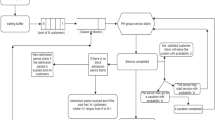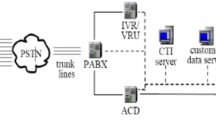Abstract
In this paper, we consider the stochastic fluid-flow model of a single node in a high-speed telecommunication network handling multi-class traffic. The node has multiple buffers, one for each class of traffic. The contents of these buffers are multiplexed onto a single output channel using one of the service scheduling policies: the Timed Round Robin Policy or the Static Priority Service Policy. The Quality of Service requirements for each class are based on cell loss probabilities. Using effective bandwidth methodologies and the recently developed bounds for semi-Markov modulated traffic, we solve call admission control problems for the two service scheduling policies at this node. We compare the performance of the effective bandwidth methodologies and the SMP bounds technique. We also numerically compare the performance of the two service scheduling policies.
Similar content being viewed by others
References
D. Anick, D. Mitra and M.M. Sondhi, Stochastic theory of a data handling system with multiple sources, Bell System Tech. J. 61 (1982) 1871–1894.
D. Artiges and P. Nain, Upper and lower bounds for the multiplexing of multiclass Markovian on/off sources, Performance Evaluation 27/28 (1996) 673–698.
C.S. Chang and J. Cheng, Computable exponential bounds for intree networks with routing, in: Proc. of IEEE INFOCOM, 1995, pp. 197–204.
G.L. Choudhury, D.M. Lucantoni and W. Whitt, On the effectiveness of effective band-widths for admission control in ATM networks, in: Proc. of ITC-14 (Elsevier Science, 1994) pp. 411–420.
C.F. Daganzo, Some properties of polling systems, Queueing Systems 6 (1990) 137–154.
N.G. Duffield, Exponential bounds for queues with Markovian arrivals, Queueing Systems 17 (1994) 413–430.
A.I. Elwalid, D. Heyman, T.V. Lakshman, D. Mitra and A. Weiss, Fundamental bounds and approximations for ATM multiplexers with applications to video teleconferencing, IEEE J. Selected Areas Commun. 13(6) (1995) 1004–1016.
A.I. Elwalid and D. Mitra, Analysis and design of rate-based congestion control of high speed networks, part I: Stochastic fluid models, access regulation, Queueing Systems 9 (1991) 29–64.
A.I. Elwalid and D. Mitra, Effective bandwidth of general Markovian traffic sources and admission control of high-speed networks, IEEE/ACM Trans. Networking 1(3) (1993) 329–343.
A.I. Elwalid and D. Mitra, Analysis, approximations and admission control of a multi-service multiplexing system with priorities, in: INFOCOM'95, 1995, 463–472.
N. Gautam, V.G. Kulkarni, Z. Palmowski and T. Rolski, Bounds for fluid models driven by semi-Markov inputs, Probab. Engrg. Inform. Sci. 13 (1999) 429–475.
N. Gautam, Quality of service for multi-class traffic in high-speed networks, Doctoral dissertation, Department of Operations Research, University of North Carolina, Chapel Hill, NC, 1997.
R.J. Gibbens and P.J. Hunt, Effective bandwidths for the multi-type UAS Channel, Queueing Systems 9 (1991) 17–28.
G. Kesidis, ATM Network Performance (Kluwer Academic, Dordrecht, 1996).
G. Kesidis, J. Walrand and C.S. Chang, Effective bandwidths for multiclass Markov fluids and other ATM sources, IEEE/ACM Trans. Networking 1(4) (1993) 424–428.
J.F.C. Kingman, Inequalities in the theory of queues, Cambridge Phil. Soc. 59 (1964) 359–361.
V.G. Kulkami, Effective bandwidths for Markov regenerative sources, Queueing Systems 24 (1997) 137–153.
V.G. Kulkarni and N. Gautam, Admission control of multi-class traffic with service priorities in highspeed networks, Queueing Systems 27 (1997) 79–97.
Z. Liu, P. Nain and D. Towsley, Exponential bounds with applications to call admission, J. Assoc. Comput. Mach. 44 (1997) 366–394.
A. Narayanan and V.G. Kulkarni, First passage times in fluid models with an application to twopriority fluid systems, in: Proc. of the IEEE Internat. Computer Performance and Dependability Symposium, 1996.
Z. Palmowski and T. Rolski, A note on martingale inequalities for fluid models, Statist. Probab. Lett. 31(1) (1996) 13–21.
S.M. Ross, Bounds on the delay distribution in G/G/1 queues, J. Appl. Probab. 11 (1974) 417–421.
H. Takagi, Analysis of Polling Systems (MIT Press, Cambridge, MA, 1986).
W. Whitt, Tail probabilities with statistical multiplexing and effective bandwidths for multiclass queues, Telecommun. Systems 2 (1993) 71–107.
J. Zhang, Performance study of Markov-modulated fluid flow models with priority traffic, in: INFOCOM'93, 1993, pp. 10–17.
Author information
Authors and Affiliations
Rights and permissions
About this article
Cite this article
Gautam, N., Kulkarni, V. Applications of SMP Bounds to Multi-class Traffic in High-speed Networks. Queueing Systems 36, 351–379 (2000). https://doi.org/10.1023/A:1011089403694
Issue Date:
DOI: https://doi.org/10.1023/A:1011089403694




